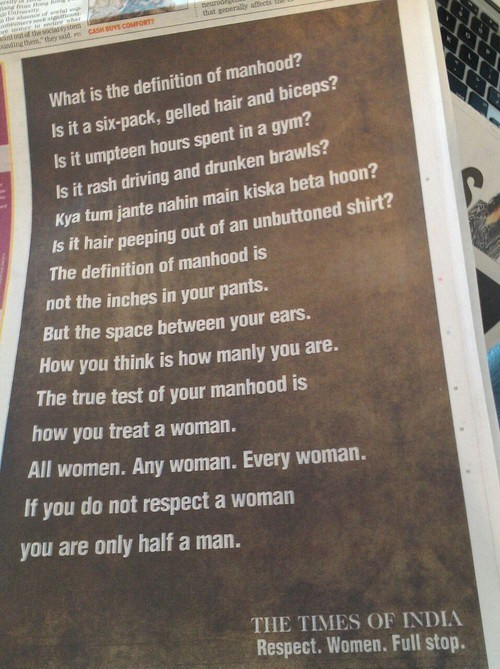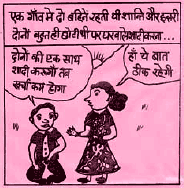india
What is the Definition of Manhood?

Well done, Times of India. (source)
My Stories
In July 2009, I noted a study concluding that Brazil’s telenovelas have inspired both a drop in birth rate and rise in divorce. Via the Communication Initiative Network, I found a a few other items on soap operas and public health:

- A German report looks at TV soap operas in Kyrgyzstan, the Dominican Republic, and Côte d’Ivoire as vehicles for HIV/AIDS education.
- A radio soap opera in Vietnam reached millions of farmers changing their attitudes and practices managing rice pests, fertilisers, and seeds.
- Authors of a 2006 paper on a radio soap opera in Bihar, India document how it spurred fundamental, sustainable shifts in people’s values and beliefs.
- A May 2008 Master’s thesis looks at the effect of two Ethiopian radio dramas on attitutde towards reproductive health and spousal abuse.
- Fans of a radio drama in Sudan learned about, or were reinforced in, the importance of abandoning female circumcision, giving girls more control of their reproductive health, having a small family, and staying away from drugs and alcohol.
And though I couldn’t find a study on its impact, straphangers in New York City may remember Julio and Marisol: Decision, an episodic comic strip soap opera dealing with AIDS that ran in English and Spanish in NYC subway cars from 1989 through 2001.
Grassroots Comics

“Almost any issue, idea or fact can be expressed in a comic. This kind of visual storytelling is flexible, attention-grabbing and relatively inexpensive.”
World Comics is a non-profit organization in Finland and India that promotes the use of local comics as a means for social change. Grassroots Comics: A Development Communication Tool (PDF) is a free, downloadable manual for other non-governmental organizations about developing comics with community activists for use in their campaigns. See examples of grassroots comics in India and Africa, as well as videos and posters from grassroots comics workshops.
Pedestrians have been ignored by urban planners who come up with fancy mega road projects that never include a decent pavement where people can walk freely and safely.… The organisation demands that pedestrians be provided a six-foot-wide walkway along the middle of the roads.”
Coconets is the winner of the 2005 BBC World Challenge, which lists other interesting environmentally friendly inventions and business initiatives. (Sponsored by Shell Oil!)
Update 3/26: Evan responds:
“I know in India they have been turning coconut husks in to rope and other fibers for a few thousand years... It takes a Development Bank to take traditional products, ignore the history, and create them again as an amazing new revolutionary product!”
Doh
The Yes Men, corporate trouble makers and designers of the WTO parody site, marked the 18th anniversary of the Bhopal disaster with the launch of Dow-Chemical.com, a straight-faced parody site using the design of the original, and a cheeky press release in the voice of the corpoation. Unfortunately, their cleverness got the best of them and the site was brought down in a matter of days. (Mirror sites are now up.)
 While funny at first, in context the parody Web site feels a bit thin. Sure it’s fun to parody the public relations language used to bathe coroporations in the soft glow of environmental and corporate responsibiliy. But also marking the anniversary were thousands of people marching in the streets of Bhopal.
While funny at first, in context the parody Web site feels a bit thin. Sure it’s fun to parody the public relations language used to bathe coroporations in the soft glow of environmental and corporate responsibiliy. But also marking the anniversary were thousands of people marching in the streets of Bhopal.
An estimated 500,000 people were affected when 40 tons of lethal gases leaked from Union Carbide Corporation’s pesticide factory in Bhopal in 1984. Today, the number of deaths stands at 20,000. Virtually nothing has been done to clean up the site, and the water used by people for everyday needs is still contaminated. And via Reuters:
“Former Union Carbide chairman Warren Anderson faces charges of culpable homicide and Indian courts have repeatedly asked New Delhi to seek his extradition from the United States where he now lives in retirement. Anderson, considered a fugitive from Indian law for refusing to face charges in its courts, could be jailed for 10 years and fined if found guilty.”
So what of design and social change? Well, a bit of design forensics determined that it was a failure of design that led to the disaster. On December 2, New Scientist published an article on their investigation of the accident and recently released documents that identify the reasons for the failure and show that the company that built and owned the Bhopal plant cut crucial corners and safety features from its design of the plant.
“Union Carbide was forced to release the documents last month by a court in New York state that was hearing a class action suit filed by Bhopal survivors in 1999. According to New Scientist, Carbide’s 1972 memo specified that the US headquarters would either perform all design work for the plant, or approve designs done elsewhere. The report said that on the basis of fresh evidence, the US Company could be tried for negligence only if the Indian government joined the campaigners in the US lawsuit.”
...
Further info via rtMark press release:
“Burson-Marsteller, the public relations company that helped to ‘spin’ Bhopal, has meanwhile sued college student Paul Hardwin for putting up a fake Burson-Marsteller site, http://www.bursonmarsteller.com/, which recounted how the PR giant helped to downplay the Bhopal disaster. Burson-Marsteller’s suit against Hardwin will be heard next week by the World Intellectual Property Organization.
Hardwin, unable to afford a lawyer, has composed a dryly humorous 57-page rebuttal to the PR giant’s lawsuit. On page 7, for instance, the student notes that Burson-Marsteller’s stated goal is
‘to ensure that the perceptions which surround our clients and influence their stakeholders are consistent with reality.’
Hardwin goes on to assert that his satirical domain is doing precisely that, by publicizing
‘academic and journalistic materials about Burson-Marsteller’s involvement with and relationship to, for example, Philip Morris and the National Smoker’s Alliance, a consumer front group designed to create the appearance of public support for big-tobacco policies; Union Carbide and the deaths of 20,000 people following the 1984 disaster in Bhopal; and political regimes such as that of Romanian dictator Nicolae Ceausescu and more recently Saudi Arabia following the events of September 11; and to properly associate them with the relevant Trademark so that they may be understood accordingly by Internet users.’
In response to the suit’s claim that ‘a substantial degree of goodwill is associated with [the Burson-Marstellar Trademark]’ Hardwin offers much ‘evidence to the contrary’ including ‘a newspaper headline in which the Complainant is characterized as “the Devil.”’
The primary goal of RTMark is to publicize corporate subversion of the democratic process. Just like other corporations, it achieves its aims by any and all means at its disposal. RTMark has previously helped to publicize websites against political parties, political figures, and entities like the World Trade Organization and the World Economic Forum.
Architects Without Borders
Arquitectos sin Fronteras is a non-profit that organizes professional architects and technicians who develop and promote the study, planning, management, design, and construction of public works projects in regions affected by poverty, discrimination, natural disasters and armed conflict. Volunteers work on everything from schools and public housing to hospitals and latrines in places from Congo to India to Peru.

